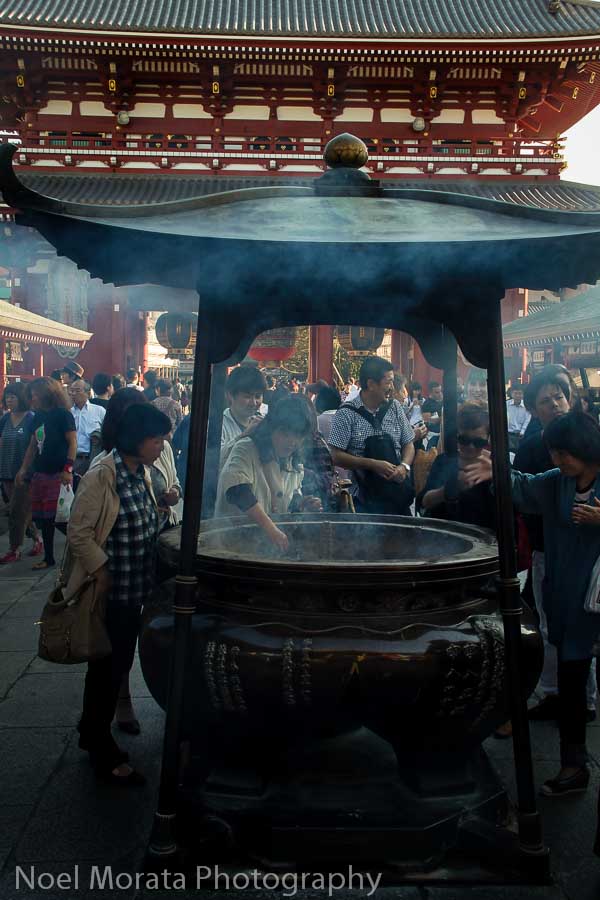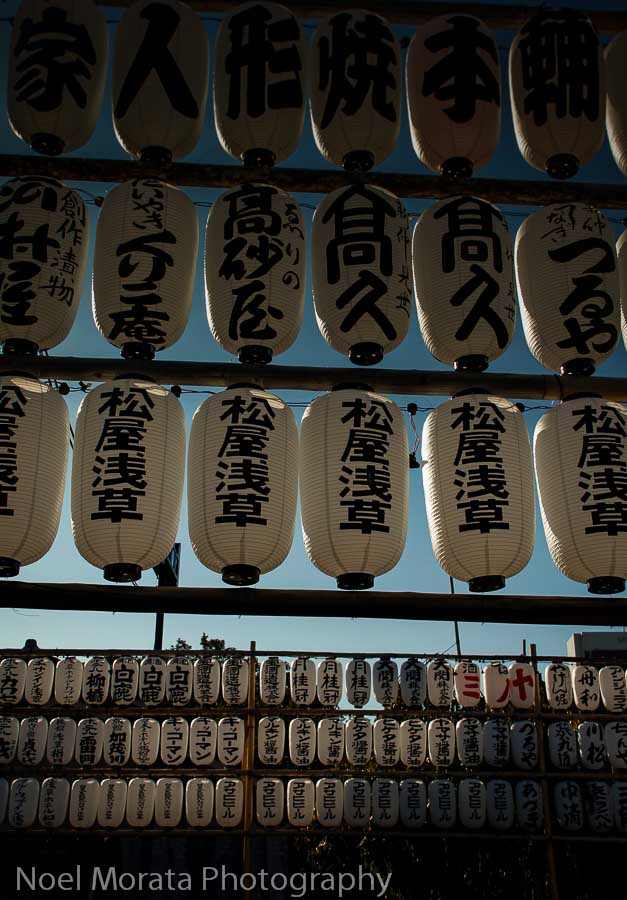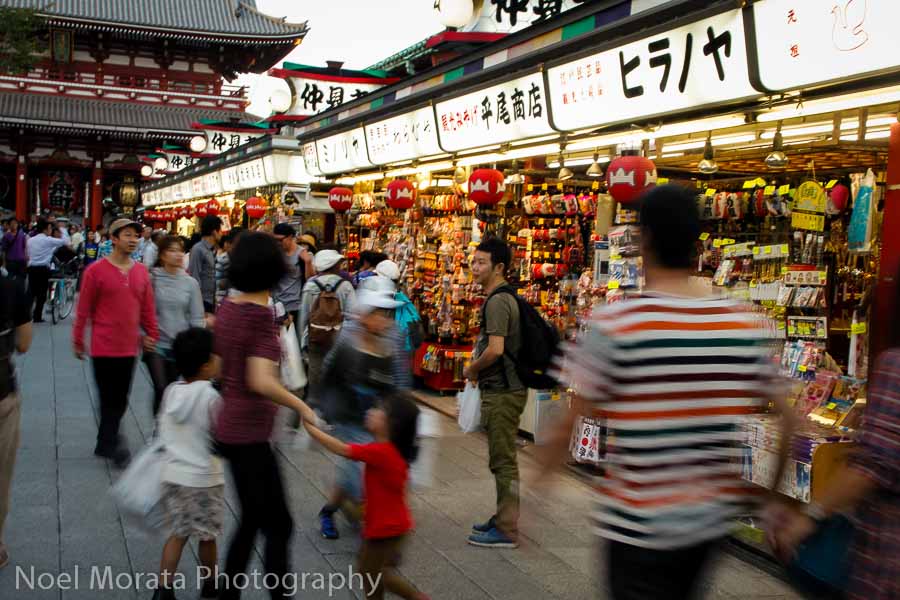Exploring Senso-Ji in Asakusa
Senso-Ji in Asakusa is Tokyo’s largest and most popular Buddhist temple with over 30 million visitors coming to visit this temple annually. Also known as the Asakusa Kannon temple, it’s the biggest tourist destination in Tokyo and worth visiting because of its history, the complex of colorful temples, shops, gardens and public buildings that give you an insight of Senso-Ji from its historic past and present day. This is also a wonderful opportunity to visit and witness the rituals of different traditional to contemporary Buddhist customs and lifestyle in Tokyo. The large area where the temple grounds are located are easy to navigate starting with the street entry to the outer gate area in the front and followed by the vendor stalls with souvenir stands where you can find local treats and temple offerings called the Nakamise Dori. The stalls are fun for visitors and locals to sample some of the local treats, seasonal special goods or to pick up an inexpensive gift or souvenir from the many stands on your way to the main temple hall called the Hondo.
Incense cleansing prior to entering the temple grounds
Views of the 5 story pagoda and the Hozomon Gate
Senso-Ji was built in 645, making it the oldest temple in Tokyo. It was dedicated to the goddess Kannon, who is the goddess of Mercy. Legend has it that two fishermen from the area where fishing in the Sumida river and pulled up a statue of the Kannon and placed it back in the river but always returned back to them. The temple was then built nearby and dedicated to the goddess of Kannon.
Before you enter the main temple grounds, you first pass through the imposing gate of the Kaminarimon (Thunder Gate), which is the outer gate of the temple and is also the symbol used to represent Asakusa and the city of Tokyo. You then pass through the Nakamise dori or the shopping street and then through the inner gate or Hozomon which finally leads to the inside area where the Hondo or main hall and pagoda tower are located.
Traditional kimono at Senso-Ji
Water purification fountain
Prior to entering the temple grounds, worshippers go to the fountain to wash their hands and mouth with the water to symbolize being cleansed and ready to enter the temple.
Entering the main temple stairs to Senso-Ji
The large Hondo or main hall and 5 story pagoda are located right after entering the 2nd gate or Hozomon Gate. These two grand structures were destroyed during the war and then rebuilt to exacting standards. There is still the intact Asakusa Shrine to the left of the main hall that was built in 1649 by the Tokugawa Iemitsu. For those interested in receiving a fortune from the temple, you visit a o-mikuji stall, for 100 donation, you can consult the oracles with a guide who will shake some labeled sticks in a can and tell you your fortune. (You will need an interpreter to do this). If you receive a bad fortune, you can tie these to the racks outside to take away that bad fortune. Behind the main front altar area is the hidden Kannon that worshippers come to visit and pay homage.
The entry of Senso-Ji and the coin box
Worshippers stop at the entry and coin box to drop some coins, clap their hands twice and bow twice before saying a short prayer prior to entering the main hall. There are other rituals that happen inside the temple that includes more incense offerings, clappings, bowings and other protocols that are fascinating to observe but unknown to a non-practicing visitor to this holy Buddhist temple.
Temple details and intricate carvings
Lantern displays at Senso-Ji
Beautiful water features at Senso-Ji
The vendor stalls at Senso-Ji
Before you enter the main temple grounds and second interior gate, you pass through the colorful Nakamise, which is a shopping street filled with vendors selling souvenirs, local snacks and foods and other cheap gift items. Vendors sell specialty foods and snacks that are either made on the premisys or in the neighborhood and you can also sample many of the snacks that are being sold by the vendors, many are sweeet and also savory delicacies. Popular takeaways include the Soy rice crackers, Agemanju (battered and deep fried soft cake filled with red bean paste) and Ningyoyaki (cake with red bean paste filling). Just to the side streets of Nakamise are a variety of other shops, cafes and eateries for those that want to stay and enjoy a wonderful meal nearby.
Tasting free samples from the Cracker vendors
Exploring the streets around Asakusa
The streets surrounding Senso-Ji and Asakusa are wonderful to explore and filled with shops and galleries along with plenty of restaurants to check out for a nice Japanese meal. Also close by is the large Tokyo Skytree tower which is the tallest structure in Japan. You can visit the upper observatories at the Skytree for a nominal charge to view some spectacular views of the entire city below.
Tips to visiting Senso – Ji temple
The temple is free and open to the public to visit
Visiting hours are 6-5pm (April – September), 6:30 – pm (September – March)
Temple grounds are always open
You can easily get to the temple by Metro to the Asakusa station with a short walk to the entrance
The main hall and gates are illuminated from sunset to 11pm and offers fantastic night photography
This is a holy temple so please be respectful of the area and worshippers
Thanks for visiting this post about Exploring Senso-Ji in Asakusa. If you enjoyed the images and post, could you please share it with any of the social media buttons located around the post. I have just posted about some of my favorite photography spots in Tokyo worth visiting, please check out my post below for some great tips of places in the city you need to see to capture some great shots of the city.
Tops places to photograph in Tokyo, Japan
If you like what you see, come and check out my other social media channels for more updates, including Instagram, Pinterest and Twitter















Always love traveling vicariously through your eyes Noel, as you are so good at capturing the essence of a destination. I’ve always been attracted to Japan’s customs and aesthetic and this post of Senso-Ji in Asakusa reinforces all that I feel about the culture! Hope to get there one day.
Possibly my favourite collection of your photos yet. So engrossed in the pictures that I’ve not read any of it yet but will go back and read now. Looks like a fbaulous place to explore.
I have never been to Japan and Tokyo is at the top of my list. I just love the architecture and the culture. Wouldn’t mind grabbing me some of those paper lanterns as well 🙂
I visited this temple on my visit to Tokyo last year. Such a great experience, from the vendors as you walk to the temple to picking your fortune (I got a good fortune!). It looks to have been similarly busy to when I was there, but I understand that sometimes it gets so busy that you can barely move!
Japan is so interesting, and your photos are wonderful. I hope to get there some day.
Great pictures and a great trip! I love doing cleaning using the water at these temples. I also love getting my fortunes told from those little boxes everywhere ahah
It must be especially fascinating to visit a Buddhist temple that still has active worshippers.
We love Senso-Ji temple and Asakusa, and are always bemused by the contradictions found there; but that is Japan, a mix of the old and the new, both existing so well together.
Japan is high on my wishlist for being so different from my own culture. Your narrative and fabulous photographs offer a fascinating insight, thank you.
I have not yet been to Japan – Your photos all look like they are from a book. Truly beautiful. I love the vibrant colors. Thanks Noel!
While I haven’t visited Japan, I can enjoy being an armchair traveler to this exotic place through your words and, as always, fantastic photography…
Great photos as usual. Senso-Ji in Asakusa looks beautiful. I love the idea of hanging a bad fortune on a rack to take it away.